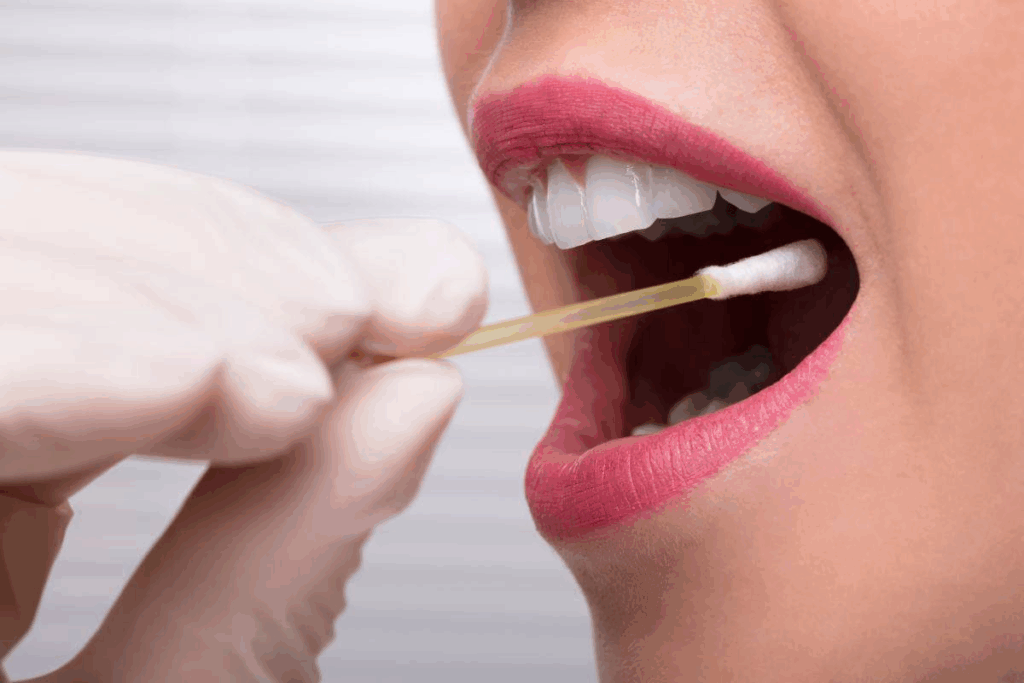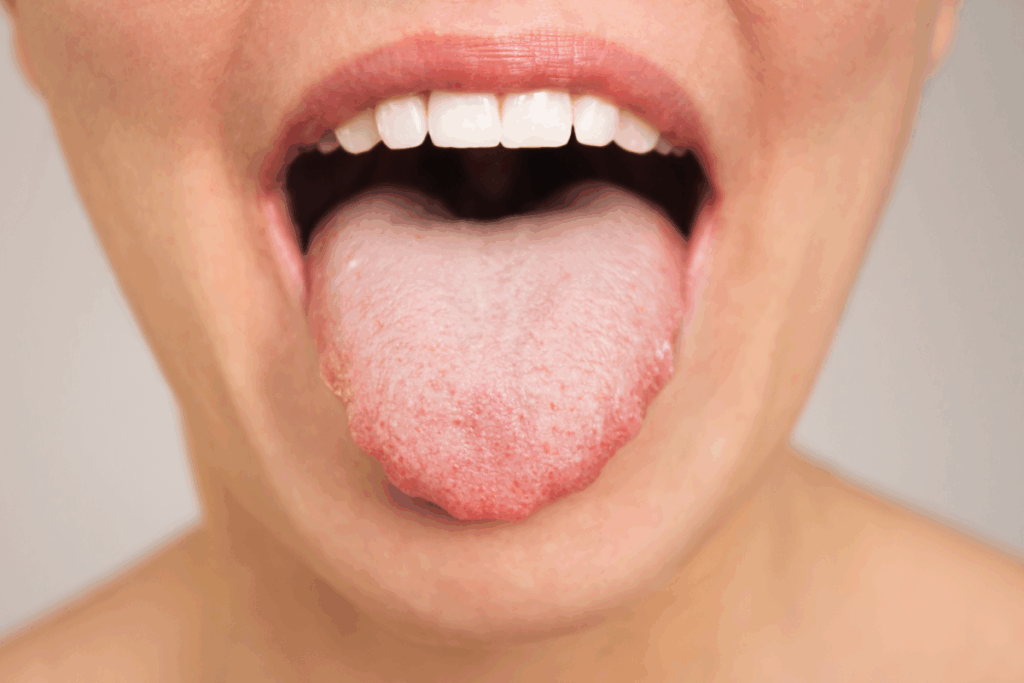Last Updated on November 27, 2025 by Ugurkan Demir

Oral cancer is a serious health issue. It can be treated well if caught early. Medical Expert, an oncologist at Medical organization, says, “Oral cancer is curable if detected at an early stage.” It’s important to know what oral cancer looks like. Early signs of tongue cancer: A visual guide to recognizing the initial appearance of a small, non-healing ulcer or patch.
It can show up as white or red patches on the gums, tongue, or inside the mouth. These patches, called leukoplakia, are often flat and painless. They don’t go away easily.
At Liv Hospital, we focus on your oral health. We do thorough screenings and check-ups early. Knowing the beginning stages of mouth cancer helps us act fast. This can lead to better treatment results.

It’s key to know about oral cancer for early detection and treatment. Oral cancer includes many types of cancers in the mouth, throat, and nearby areas. It’s a complex condition to diagnose and manage.
Oral cancer is when abnormal cells grow out of control in the mouth. This includes the lips, tongue, cheeks, gums, and throat. The most common type is squamous cell carcinoma, making up about 90% of cases.
Other types include:
Oral cancer is a big health issue in the United States. The American Cancer Society (ACS) says about 54,000 new cases are diagnosed each year. By 2025, they expect 59,660 people to be diagnosed with oral or oropharyngeal cancer.
Year | Estimated New Cases |
2023 | 54,000 |
2025 | 59,660 |
Finding oral cancer early is very important. Early detection means better treatment chances. It also lowers the risk of serious problems and improves survival rates.
We stress the need for regular oral exams and screenings. This helps catch issues early before they get worse.

Early stage oral cancer shows up as visible changes in the mouth. You might see white and red patches that hint at problems. Spotting these signs early is key to catching the disease.
White patches, or leukoplakia, are a common sign of early oral cancer. They can pop up on the gums, tongue, or other parts of the mouth. These patches are usually flat and don’t hurt. Doctors say leukoplakia might turn into cancer, so it needs a closer look.
Red patches, or erythroplakia, are another sign of early oral cancer. They look red and soft, unlike the white patches of leukoplakia. Medical Expert, a head and neck surgeon, says red patches are more serious but both should be checked if they last for weeks.
Early oral cancer can also show up as mixed red-white patches, called erythroleukoplakia. These patches mix the looks of leukoplakia and erythroplakia. Seeing these patches means you might be at higher risk for cancer, making it important to see a doctor right away.
Spotting these signs early is critical for catching oral cancer. If you see anything odd in your mouth, see a doctor for a check-up and diagnosis.
“The key to successful treatment of oral cancer lies in early detection. Being aware of the visual signs can significantly improve outcomes.”
Medical Expert, Oral Cancer Specialist
Knowing the early signs of tongue cancer is key for quick medical help. Spotting these signs early can greatly improve treatment chances.
One early sign is a change in the tongue’s look or feel. You might see white or red patches, a thicker tongue, or lumps. Medical Expert, including changes in the mouth’s look.
These changes might be small and easy to miss at first. But if you notice anything odd on your tongue that lasts, see a doctor right away.
Persistent sores that won’t go away are another sign. These sores might be painless or hurt a lot and can bleed easily. It’s important to tell the difference between normal sores and ones that could be serious.
If a sore on your tongue lasts more than two weeks, get medical help. Medical Expert’t heal is a big warning sign that needs checking.
Pain, numbness, or sensitivity changes in the tongue or mouth are also signs. These can make eating, speaking, or swallowing hard. Pain or numbness that lasts and isn’t from an injury should be checked by a doctor.
Also, being more sensitive to hot or cold foods and drinks is a sign. If you notice these changes, talk to your doctor to find out why.
Knowing these signs can help you catch tongue cancer early. Regular dental visits and watching for mouth changes are important. They can help spot problems early.
The mouth is a complex place where oral cancer can start in different spots, like the gums and the floor of the mouth. Knowing these spots and their signs is key for catching cancer early and treating it well.
Oral cancer on the gums or cheek lining might show up as white or red patches, or both. These patches might not hurt at first, so it’s important to check your mouth often. Look for any odd changes in color or texture.
The floor of the mouth and the palate are also common places for oral cancer. You might feel pain or numbness, or have trouble swallowing. If you notice any sores or changes in these areas, see a doctor right away.
Changes in the lips can also signal oral cancer. Watch for any sores, lumps, or color or texture changes. The American Cancer Society (ACS) says that stage 1 oral cancer on the lips has a 94% survival rate. This shows how important it is to catch cancer early, based on where it is.
Knowing these signs can really help us find oral cancer early, when it’s easier to treat. Regular self-checks and doctor visits are key to keeping your mouth healthy and catching problems early.
It’s important to know the difference between cancerous and non-cancerous oral conditions. This helps in early detection and treatment. Oral cancer can look like many other conditions, making it hard to tell them apart.
Some oral conditions look like oral cancer but are not. These include:
Medical Expert, “Canker sores are painful but not cancerous. They usually heal in 2 weeks. Any sore, lump, or spot in your mouth that lasts longer needs a doctor’s check-up.”
Some signs may point to a cancerous lesion. These include:
Knowing these signs is key to getting a medical check-up on time.
Any lasting or concerning oral change needs a doctor’s check-up. Early stage oral cancer can be treated well if caught early. If you have pain or trouble swallowing, or notice unusual changes, see a doctor right away.
We stress the need for regular oral check-ups and watching for mouth changes. Early detection is vital for managing oral cancer well.
Many factors can increase your chance of getting oral cancer. Knowing these can help prevent it. It’s important to understand them for early detection and treatment.
Tobacco, like smoking or chewing, is a big risk for oral cancer, says Medical Expert. Using tobacco and alcohol together raises the risk even more. This makes stopping them key to prevention.
Tobacco and alcohol cessation programs are important. They help lower oral cancer rates. People who use these substances should watch for signs of cancer and get checked often.
Human Papillomavirus (HPV), mainly HPV-16, is linked to more oropharyngeal cancers. HPV-related oral cancers are becoming more common. Knowing this helps in prevention and treatment.
Research is ongoing on HPV’s role in oral cancer. But, getting vaccinated against HPV might help prevent some oral cancers.
Age is a big risk factor, with most cases in people over 40. Men are more likely to get oral cancer, but the gap is getting smaller. Some genetic conditions also raise the risk.
Knowing these risk factors helps everyone stay alert for early signs of oral cancer. This can lead to better outcomes by catching it early.
Diagnosing early oral cancer involves physical exams and advanced tech. Finding cancer early is key to better treatment. A detailed check is needed to spot oral cancer early.
The first step is a visual check and physical exam by a healthcare pro. Medical Expert, “Your doctor or dentist will look for sores or white patches to check for oral cancer.”
They’ll search for any mouth abnormalities. This includes white or red patches, sores, and changes in the tongue or tissues.
If something looks off, a biopsy might be needed. This means taking a small tissue sample for a microscope check.
There are a few biopsy types:
The tissue is then checked for cancer cells. This is key to knowing if there’s cancer and what stage it is.
Along with exams and biopsies, advanced imaging is used. This includes:
These tests help doctors see how big the cancer is. They plan the best treatment based on this.
Finding oral cancer early is very important. The American Cancer Society says stage 1 has a much better survival rate than later stages.
Stage | 5-Year Survival Rate |
Stage 1 | 80-90% |
Stage 4 | Less than 40% |
Knowing how to detect cancer early can help. It’s important to see a doctor quickly if you notice any mouth changes.
It’s important to know the difference between cancerous and non-cancerous oral conditions. This knowledge helps in early detection and treatment. Oral cancer can take many forms, and not all mouth problems are serious. It’s key to tell the harmless from the potentially dangerous ones to get timely help.
Some mouth issues can look like cancer but are not. These include canker sores, oral thrush, and lichen planus.
Medical Expert, “Canker sores are often painful, but they’re not malignant.” Knowing about these conditions helps us spot when something is off.
Some signs of oral lesions suggest a higher risk of cancer. These include:
Knowing these signs can lead to early medical visits, which is important for early gum cancer symptoms.
Being alert to mouth changes is vital. If you see anything unusual that lasts, see a doctor. Early detection is critical for understanding what does stage 1 mouth cancer look like and treating it well.
Symptom | Description | Action |
White or red patches | Leukoplakia or erythroplakia that persist | Consult a doctor |
Unexplained bleeding | Bleeding without an obvious cause | Seek medical attention |
Persistence | Sores or lesions that don’t heal | Get a professional evaluation |
Knowing the risk factors for oral cancer is key to preventing it. By understanding these factors, people can lower their risk of getting this serious disease.
Tobacco use is a major risk for oral cancer, as Medical Expert. The chemicals in tobacco harm the DNA in mouth cells, leading to cancer. Drinking too much alcohol also raises the risk, as it irritates the mouth and makes it more vulnerable to cancer-causing substances.
Key risks associated with tobacco and alcohol use include:
Human Papillomavirus (HPV) infection, mainly HPV-16, raises the risk of oral cancer. HPV-related oral cancers often happen in younger people and aren’t linked to tobacco use.
The role of HPV in oral cancer highlights the importance of:
Age is a big risk factor, with most cases happening in people over 40. Men are more likely to get oral cancer, but the gap is getting smaller. Genetic predisposition also plays a part, with some genetic syndromes increasing the risk.
Understanding these risk factors can help in:
Doctors use a detailed approach to spot oral cancer early. This involves several important steps to find cancer at its earliest stage.
The first step is a thorough check-up and physical exam. Medical Expert, “To find oral cancer, your doctor or dentist will do a physical exam.” They look at your mouth, lips, and throat closely. They also feel for any unusual areas.
If something looks odd, a biopsy is done next. A biopsy takes a small tissue sample from the area. Then, the tissue is checked under a microscope for cancer cells. This step is key to confirm if you have oral cancer.
Advanced tools also help in diagnosing. X-rays, CT scans, MRI scans, and PET scans show how far the cancer has spread. These tools help doctors make the right treatment plan.
By using these steps, doctors can find oral cancer early and treat it well. Finding cancer early greatly increases the chance of successful treatment.
Early detection of oral cancer offers many treatment options. These can improve survival rates and quality of life. When caught early, oral cancer is more likely to be treated successfully.
Surgery is a common treatment for early oral cancer. The aim is to remove the cancer while keeping healthy tissue. Surgical methods depend on the tumor’s size and location.
For small tumors, a simple cut might be enough. But bigger tumors might need more complex surgeries. These surgeries help restore the patient’s look and function.
Surgery can seem scary. But, new surgical methods have greatly improved results for oral cancer patients. Today, surgeons use less invasive techniques. This reduces recovery time and scarring.
In some cases, radiation therapy is recommended. Radiation uses high-energy beams to kill cancer cells. It’s very effective for early oral cancers. Chemotherapy or targeted therapy might also be used to prevent cancer from coming back.
We help patients choose the best treatment plan. We consider the cancer’s stage, location, and the patient’s health.
Recovery from early oral cancer treatment varies. Follow-up care is key to watch for cancer return and manage side effects. Patients learn how to manage pain, diet, and oral care.
The American Cancer Society says stage 1 oral cancer survival rates are good. Early detection and treatment greatly improve these rates. We stress the need for follow-up appointments to catch any problems early.
Knowing about early oral cancer treatment and survival rates helps patients make informed choices. We aim to support our patients fully, ensuring the best outcomes.
Understanding the early signs of tongue cancer is key. Being aware of early oral cancer on gums is also important. Medical Expert, “Early detection is the key to earlier treatment and improved outcomes for oral cancers.” By recognizing these signs, we can take steps to protect our health.
We urge everyone to watch their oral health closely. Look out for any changes that could mean trouble. Regular dental visits and self-exams can catch problems early. If you see something odd, get it checked right away. Early action is vital in fighting oral cancer.
By staying informed and proactive, we can help those with oral cancer. Let’s stay alert and take care of our mouths. This way, we can all work towards better health outcomes.
Early signs of oral cancer include white or red patches in the mouth. You might also notice persistent sores, pain, or numbness. Changes in the tongue or lips’ appearance or texture are also signs.
Early stage oral cancer can show up as white patches (leukoplakia), red patches (erythroplakia), or mixed patches (erythroleukoplakia) in the mouth.
Look for signs on the gums and cheek lining. Also, check the floor of the mouth and palate for indicators. Changes on the lips are another clue.
Risk factors include tobacco and alcohol use, HPV infection, and age, gender, and genetic predisposition.
Early oral cancer is diagnosed through screening and physical exams. Biopsy procedures and advanced imaging are also used.
Treatment options include surgical approaches, radiation, and adjuvant therapies. The recovery process and follow-up care are also important.
Yes, oral cancer can be painful, but it’s not always the case. Early stage oral cancer might not be painful.
Be aware of common benign oral conditions and warning signs of cancer. Knowing when to worry about oral changes is key.
Early detection is vital in oral cancer. It can greatly improve treatment outcomes and survival rates.
Symptoms include changes in the tongue or lips, persistent sores, and pain or numbness.
Dying from oral cancer can be painful if not managed well. But, with proper palliative care, suffering can be alleviated, improving quality of life.
National Center for Biotechnology Information. (2025). What Does Early Stage Oral Cancer Look Like. Retrieved from https://www.ncbi.nlm.nih.gov/books/NBK565867/
Subscribe to our e-newsletter to stay informed about the latest innovations in the world of health and exclusive offers!